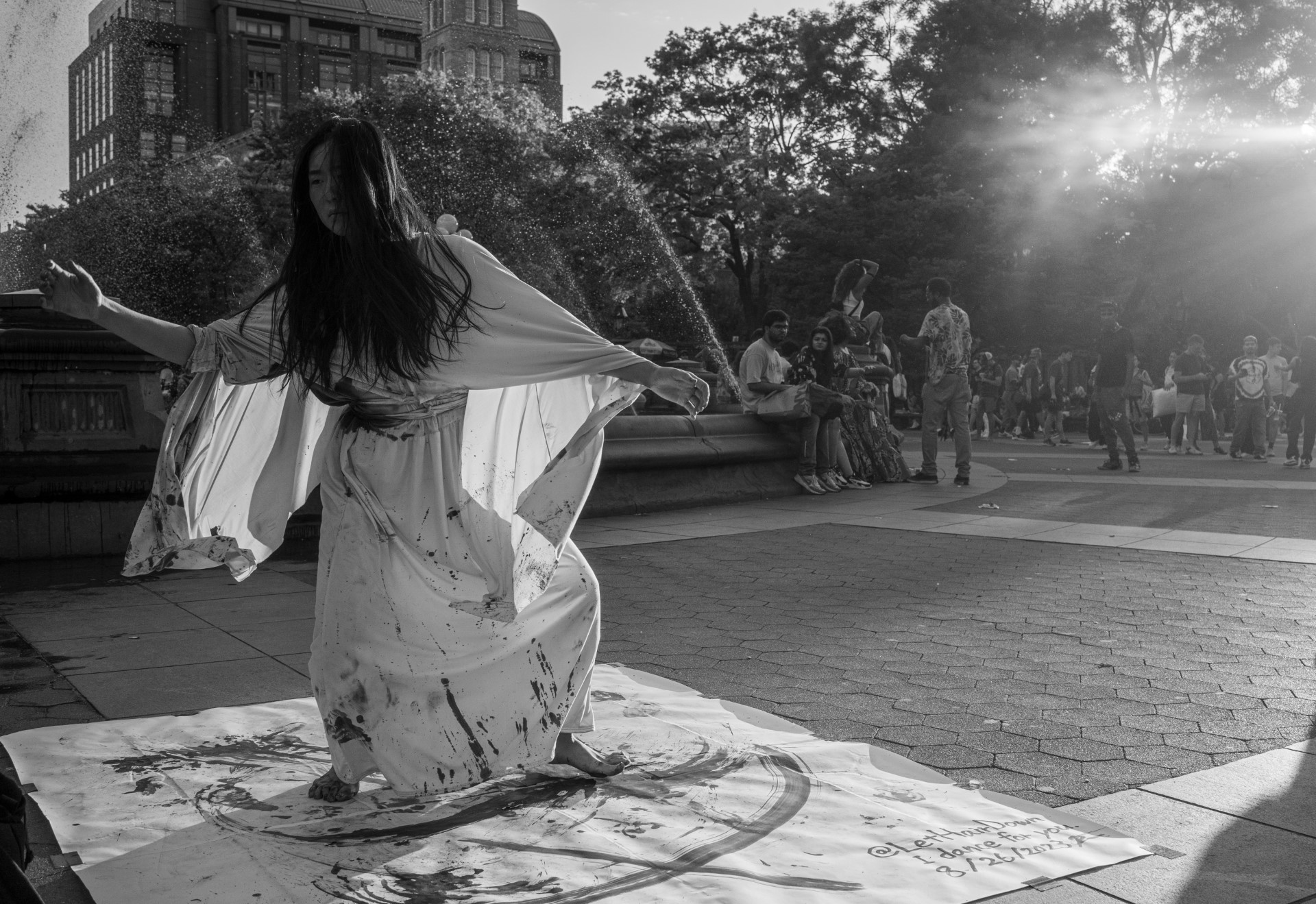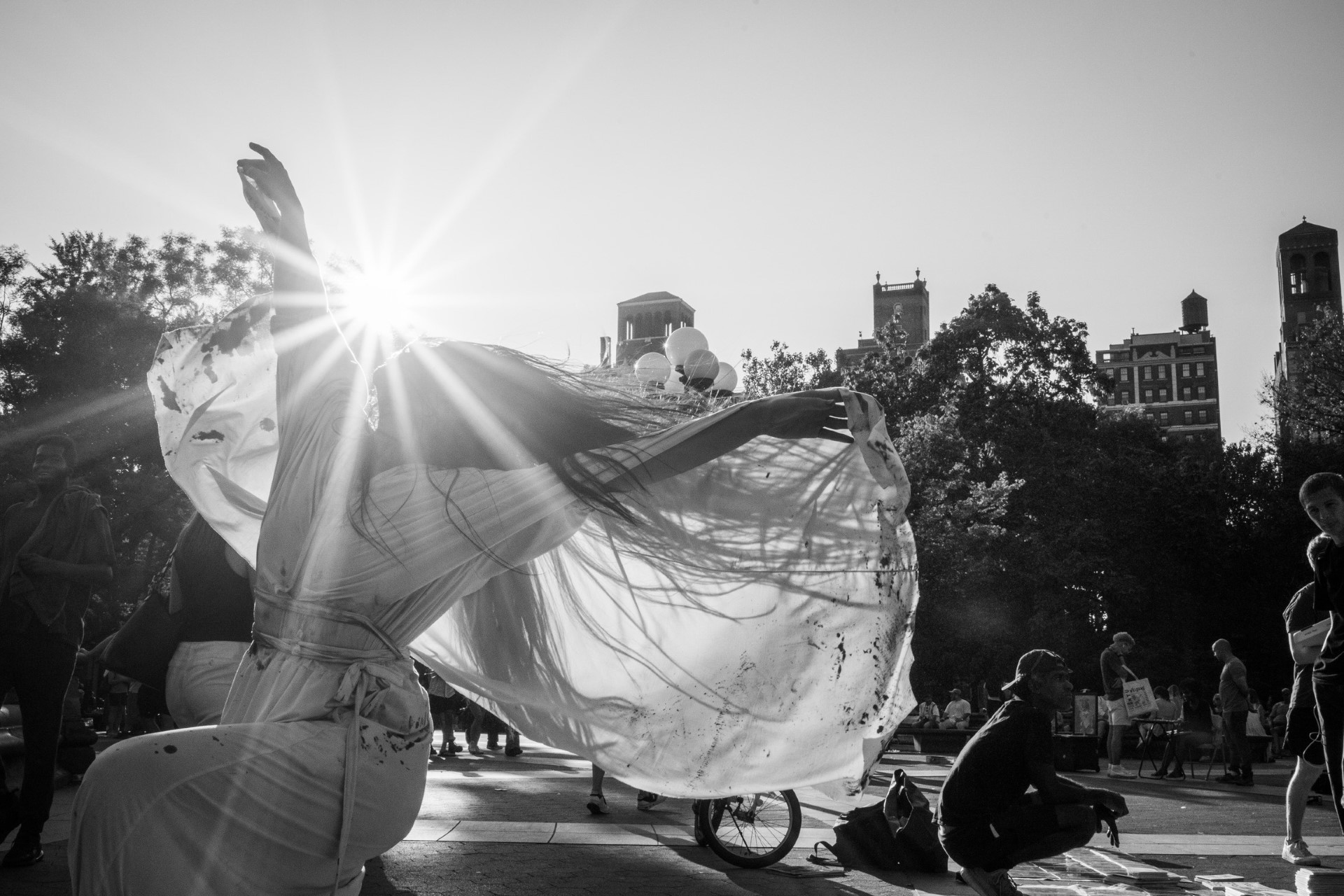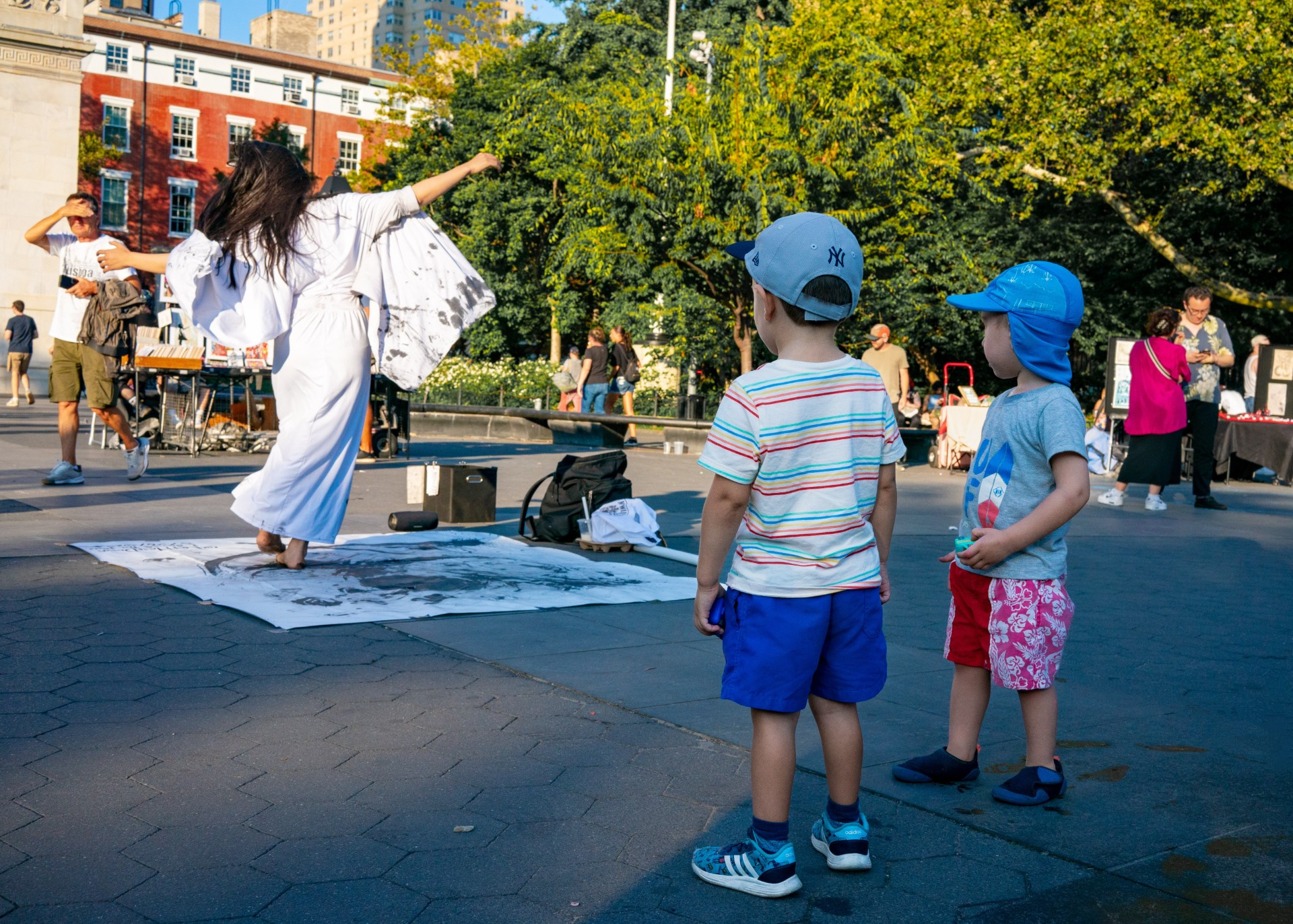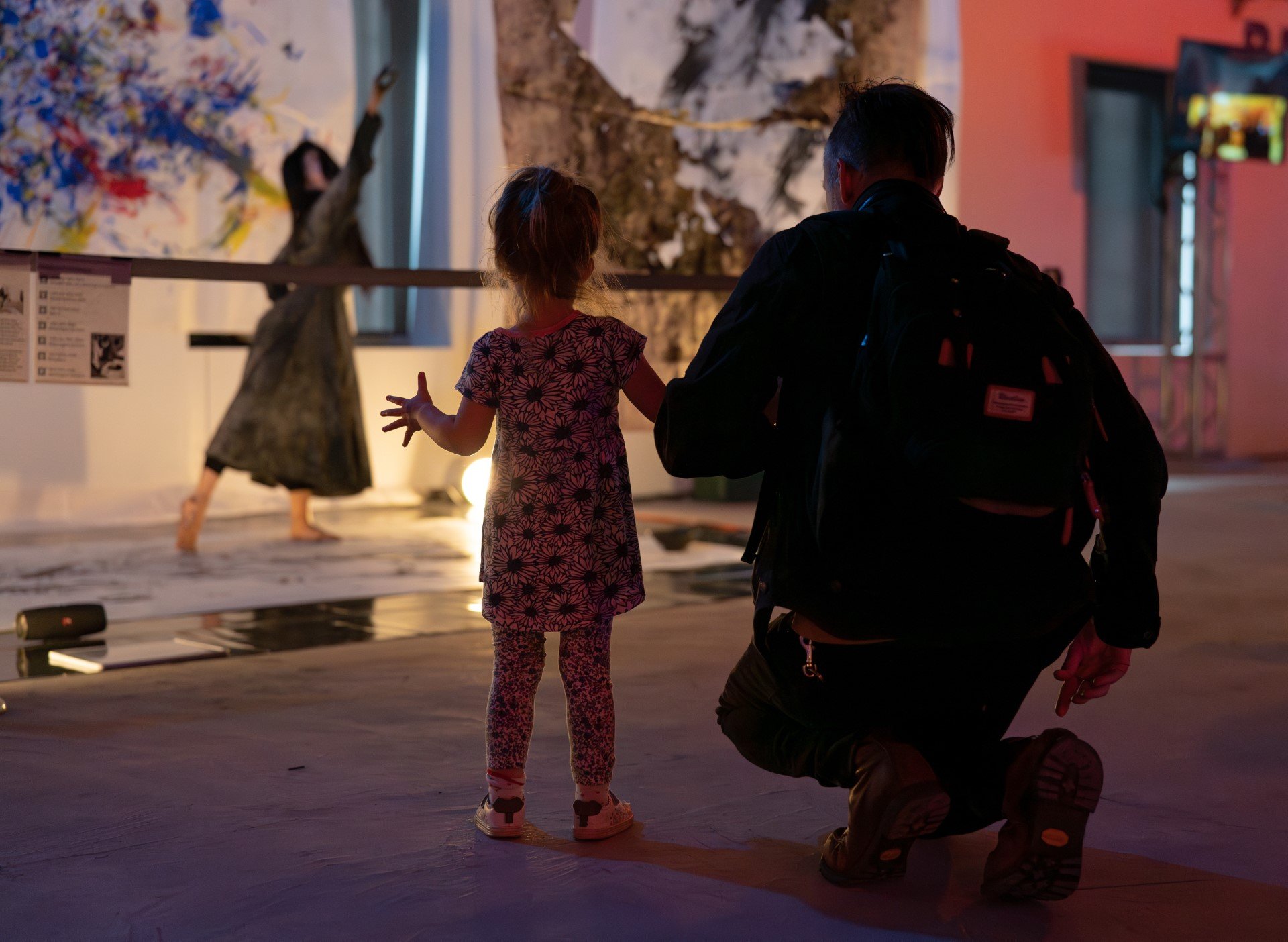Laia Llobera in Conversation with Performing Artist Kanami Kusajima
Kanami Kusajima (working professionally under the name of Let Hair Down) is a dancer, choreographer, improvisation teacher, and performing artist based in New York City. She began dancing at the age of six in a local dance studio in Japan and later trained in different styles of dance, physical expressions, and performing arts. In 2020, she graduated Summa Cum Laude with a BFA degree in Dance from SUNY Purchase College. Throughout her career, she has performed in dance works by impressive choreographers, including Martha Graham, Francesca Harper, Yoshiko Chuma, Ana Maria Lucaciu, Erin Landers, and Meagan Ahern.
Furthermore, Kusajima is currently performing at Washington Square Park, where she dances to any kind of music requested by passersby while painting with her feet as she moves, under the artistic name “Let Hair Down”. She was featured in a NYC recovery promotional project “No Stopping New York” led by the NYC government in the 2021 summer season, which granted her ample press coverage (New York Magazine, The Independent, The Guardian, and The Village Sun, among others).
In this exclusive with MADE IN BED, Kusajima talks about her approach to dance, making a life for herself as a street performer, and the stressful reality of busking artists.
Courtesy @velocityzen.
Laia Llobera: As a street performer, you use the name Let Hair Down. Is there any reason behind it?
Kanami Kusajima: I started my street performance as a collaboration with Pinokio, another Japanese performer whom I met in Washington Square Park back in 2020. At this point, he had already been doing these live painting performances for four years. He used to hide his face behind a mask, and since I wanted to match his aesthetics, I chose to hide mine behind my hair, which I usually do. When he went back to Japan, he encouraged me to continue dancing by myself. At that time, New York had all buskers in lockdown, and everything was online since the venues were closed and gatherings were not allowed. It was a moment when street performance was especially relevant.
To “let your hair down” is another way of saying “to relax” in English, something I came to know after I had taken on this pseudonym, and I find it appealing since a lot of people sit and decompress while I dance. The way I use “let hair down” is intentionally grammatically incorrect, but I want to keep it that way because I am not a native speaker and because I don’t want to use an imperative form that tells people what to do.
LL: What does dancing mean to you?
KK: Dancing is like eating; you dance to stay alive, but, in the same way, eating too much or too little is harmful. So, I try to maintain a balance.
My motto is “I dance for you” because I want to share my energy with the community. But, at the same time, it helps my emotional and physical health. So even if nobody is watching, I dance for myself because when I say, “I dance for you”, that ‘you’ also includes me.
Courtesy @nonsleeper.
LL: How does street performance differ from stage performance?
KK: Performing in huge venues means that performances involve a large audience and are more structured. Street performance is, paradoxically, more intimate because there’s a body-to-body connection.
In a closed, private space, people expect to see art. Street performance is something people do not expect to see often in space traditionally reserved for showcasing normal art practices. Therefore the attitude of the audience is very different. They might or might not be prepared to receive the performance, and that allows for genuine reactions. Kids and animals are a great audience because they have no filters when it comes to showing how scared, confused, or curious they are. I don’t look for positive reactions; I look for honest ones. A woman once messaged me to explain how my performance in the rain encouraged her to engage in mental health treatment. She then got a job in Washington and contacted me to purchase one of my paintings.
LL: Can a street performer make a living out of their performances?
KK: Personally, I make my living from street performances, but it is difficult, so I cannot guarantee that anyone can make it and support themselves this way. The community around Washington Square Park helps, and since I got noticed by newspapers, now I even perform at galleries and venues, which also helps. Nonetheless, I never tell newspapers how much I make out of my performances because once someone sees a number, they forget about everything else.
There was this woman who once reached out to give me money. She was homeless. It was a one-dollar bill. I became frozen and hesitated if I should give it back to her, but I decided to honor her choice and respectfully receive it. After that, the dollar bill in my hand is not a dollar bill anymore. You can’t buy much with it, but for me and for that lady, that dollar is worth much more than a thousand other things. So, if someone asks me how much I receive as a donation, I need to explain all of this using experiences such as this and abstain from using numbers. Otherwise, they just split it into “this much per hour and this much per day”. They compare it to other professions and draw conclusions without acknowledging that money is just a reified piece of paper that goes around society for the exchange of goods and experiences. Although I can’t deny that money is decisive in our society, the most important thing about street performance is trying not to prioritise money. Street performance is a choice you make, and it is not about making money but about genuine community service, in some way, because it entails a close bond with the community.
Courtesy: Jaime Marrero.
LL: I have seen your paintings being described as Abstract Expressionist. Do you identify with that trend?
KK: It is pretty accurate. In my paintings, I use calligraphy ink; I personally feel that its long-lasting permanence cuts something very powerful into the painting. There’s also a decisiveness to it; once the ink falls on the paper, you must take it from there. Erasure does not work in calligraphy. Once you draw a line, you must go from it.
Improvisational dance goes the same way. You cannot erase a movement. That specific moment is when everything falls with full effort. The weather also affects the consistency and look of the painting: rain results in a more watery painting, dry weather allows paintings to dry quicker, and humid days make for more fuzzy results.
LL: Aside from your performances, you work as a dance improvisation teacher. How can improvisation be taught?
KK: Improvisation, for me, entails a dimension of physicality and a question of how honest and open you can be about your feelings. And so, you must be introduced to expressing your emotions because no one is drifting you. It is almost like language learning: of course, you need to know the basics. Just like one learns the alphabet, you need to know your body and understand it to do improvisation. And after that, you must prove how you can draw upon it.
There’s an exercise I do in class: I bring a newspaper that someone holds and plays with while someone else moves their body as if it were the newspaper. If the newspaper is smashed, the dancer must smash itself. Then we’d go on to shake, move, or vibrate. It is not about how you move, but about how you interpret and express a situation, a feeling, or a space with the language that you have, the one you learned and know. You must ask how your body, with its vocabulary, can say that.
Courtesy @nonsleeper.
LL: You were the face of the recovery project “No Stopping New York” during the pandemic, but now you are being harassed by the police for performing on the street. How does that feel?
KK: I gave away my image rights for free for the campaign, and now there’s “no stopping New York”, but they are stopping me because the police insist that I need to get permits, even though there’s no permit for buskers who perform daily. There is a clearance of $70 per day meant for organisation’s single-day events, but we are individuals, and we perform every day. Because the freedom of speech and expression is protected in the First Amendment of the U.S. Constitution, street performers are just executing their constitutional rights, and it has to be protected, unless the performance is significantly harming other people’s health and equality of life. Since the constitution is the highest law of the country, if the park rules do not respect the Constitution, those park rules need to be changed. I launched a petition where we asked for a reassessment of the norm, and I had a meeting with a spokesperson from our district. Although they told us that the police officers would be asked to be more permissive, no changes have been made.
I don’t ask to dance late at night, play loud music, or do anything that would make the area uncomfortable for the community. Lawmakers don’t spend much of their time in the park, and they make the laws in the office without meeting the needs of the artists or acknowledging the human relations within the community. I just ask for a middle ground.
Street performance is part of New York’s culture; tourists and locals alike enjoy it and that is why New York City’s government used my picture to promote the resilience of the city. There is even a video of local people defending me from Rangers! So, sometimes you wonder which community they are protecting and from whom.
Courtesy @velocityzen.
Many thanks to Kanami Kusajima on behalf of MADE IN BED. To learn more about Kusajima’s practice and performances, visit her website and personal (@kanami_kusajima) and artist (@lethairdown) Instagrams.
Laia Llobera
Contributing Writer, MADE IN BED








